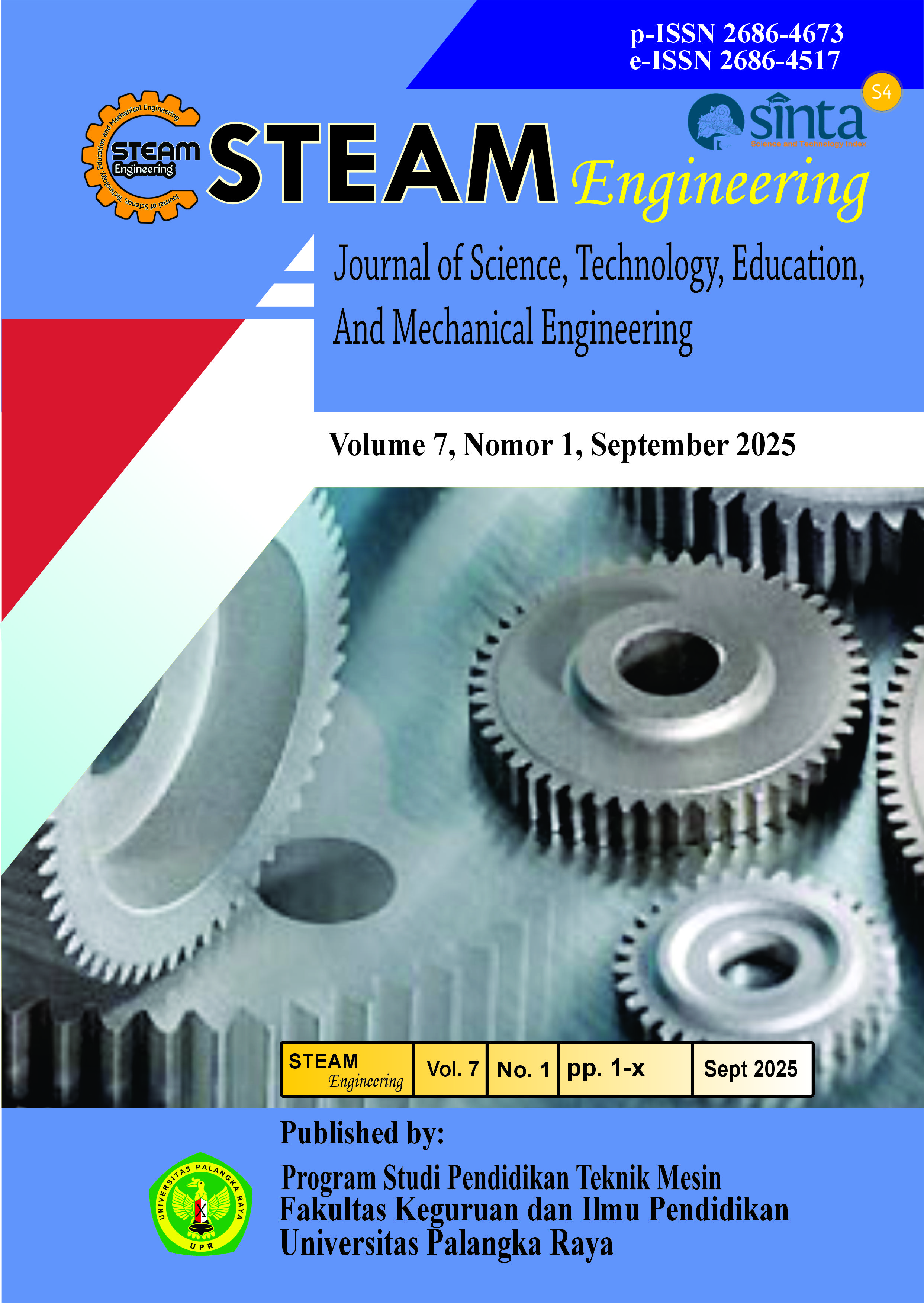ANALISIS BOTTLENECK PERAKITAN METAL BOX DENGAN METODE SIMULASI DISKRIT MELALUI SOFTWARE PROMODEL
DOI:
https://doi.org/10.37304/jptm.v7i1.22818Keywords:
Diskrit Simulation, Diskrit Simulation, ProModel, ProModel, Bottleneck Analysis, Bottleneck AnalysisAbstract
Bottlenecks are a major cause of productivity decline in manufacturing systems. In the PDAM metal box industry at PT. MNO, the production process frequently encounters constraints that reduce output. This study employed discrete event simulation using ProModel software. The research stages included field observation, process time data collection, data distribution analysis with Stat::Fit, and model validation through Chi-Square and Mann-Whitney tests. The simulation revealed a significant bottleneck in the assembly workstation, with utilization reaching 93.64%, while production output was limited to 22 units during a 7-hour working shift. In contrast, the finishing station experienced idle time. An improvement scenario involving the addition of one workstation and one operator in the assembly and finishing processes is recommended to reduce production flow imbalances. This study confirms the effectiveness of discrete event simulation as an analytical tool for production system optimization and highlights opportunities for further development through digital twin integration and metaheuristic optimization
Downloads
References
Banks, J., Carson, J. S., Nelson, B. L., Nicol, D. M., Fabrycky, W. J., & Mize, J. H. (2013). Discrete-Event System Simulation Five Edition (5th ed). Prentice Hall.
Benfer, M., Heyer, V., Brützel, O., Liebrecht, C., Peukert, S., & Lanza, G. (2024). Analysis of metaheuristic optimisation techniques for simulated matrix production systems. Production Engineering, 18(1), 159–168. https://doi.org/10.1007/s11740-023-01225-3
Blanchard, B. S. ., & Fabrycky, W. J. . (2023). Systems engineering and analysis (5th ed). Pearson Education Limited. https://www.pearson.com/en-us/subject-catalog/p/systems-engineering-and-analysis/P200000003367/9780137980888
Chafifah Wulandari, A., Witonohadi, A., & Puspitasari, F. (2023). Perancangan Model Simulasi dan Perbaikan Lini Produksi Pompa Air Tipe PS-135 E Menggunakan Simulasi Diskrit dan Theory Of Constraint pada PT. Tirta Intimizu Nusantara. Jurnal Teknik Industri, 13(1).
Dio, R., Aulia Agung Dermawan, & Putera, D. A. (2023). Optimization of the Amount of Demand and Production of CV. XYZ Uses Flexsim Simulation Software. Journal Of Industrial And Manufacture Engineering, 7(1), 59–68. https://doi.org/10.31289/jime.v7i1.9398
Harrell, Charles., Ghosh, B. K. ., & Bowden, Royce. (2012). Simulation using ProModel (3th ed). McGraw-Hill.
Ismayanti, C. Y., Kusnandar, D., & Imro’ah, N. (2019). Verifikasi Model Arima Pada Peramalan Jumlah Kecelakaan Lalu Lintas Kota Pontianak Menggunakan Statistical Process Control. Buletin Ilmiah Mat. Stat. dan Terapannya (Bimaster), 08(3), 421–428. https://doi.org/https://doi.org/10.26418/bbimst.v8i3.33246
Kelton, W. David., Sadowski, R. P. ., & Zupick, N. B. . (2015). Simulation with Arena (Lorraine Buczek, Ed.; 6th ed., Vol. 1). McGraw-Hill Education. https://eclass.aegean.gr/modules/document/file.php/211226/202014.pdf
Murdiyanto H. (2020). Obserfasi delay pada produksi keripik tempe menggunakan DES. Jurnal Ilmiah Medan, 2(3), 1–7. https://doi.org/10.573829
Law, A. M. . (2015). Simulation modeling and analysis. McGraw-Hill Education. USA.
Nur Rakhmaddian, N., Akhsani Setyo Prayoga, R., Farhan Abdillah Sholeh, M., & Melani Safitri Karoho, Y. (2023). Peramalan Permintaan Peti No. Abc Pada Industri Pertahanan Di Indonesia. Tekmapro, 18(1), 13–24. https://doi.org/https://doi.org/10.33005/tekmapro.v18i1.330
Pertiwi, R. I., & Octavianti, C. T. (2024). Model Petri Net Alur Pelayanan Resep Rumah Sakit X di Kota Malang. Jurnal UJMC, 10(1), 47–55. https://doi.org/https://doi.org/10.52166/ujmc.v10i1.6891
Pramaningrum, D. S., Fernandes, A., Iriany, A., Solimun, Budi Astuti, A., & Haneinanda Junianto, F. (2025). Simulasi Pemodelan Jalur Semiparametrik Truncated Spline pada Kasus Perkembangan Cashless Society. Jurnal Teknologi Informasi dan Ilmu Komputer, 12(1), 31–38. https://doi.org/10.25126/jtiik.2025128679
Randiva Aisyah Iskandar, A., Diastiningsih Subandi, M., Rani Br Pasaribu, R., & Wikansari, R. (2024). Penurunan Industri Manufaktur Terhadap Turunnya Ekspor Impor. Investama: Jurnal Ekonomi dan Bisnis, 10(1).
Rendra Kurniawan, & Muhammad Yasin. (2025). Dampak Revolusi Industri 4.0 Terhadap Kesiapan Indonesia. MENAWAN : Jurnal Riset dan Publikasi Ilmu Ekonomi, 3(1), 195–205. https://doi.org/10.61132/menawan.v3i1.1181
Risqi, A., & Nasution, S. (2021). Identifikasi Permasalahan Penelitian. ALACRITY : Journal Of Education, 1(2). https://doi.org/https://doi.org/10.52121/alacrity.v1i2
Ruslim, R., & Sutapa, N. (2020). Pembaruan Standar serta Peningkatan Efektivitas dan Efisiensi Proses Loading Unit dengan Simulasi Flexsim. Jurnal Titra, 8(2), 289–296. https://doi.org/https://doi.org/10.31955/mea.v8i3.4468
Rustiawati, R. B., & Lubis, A. F. (2019). Aktivitas Ekspor dan Inefisiensi Teknis Industri Andalan Ekspor Indonesia. Jurnal Ekonomi dan Pembangunan Indonesia, 19(2), 224–241. https://doi.org/10.21002/jepi.2019.14
Sarı, H., & İç, Y. T. (2024). The new fuzzy bottleneck model to improve the axle manufacturing system performance. International Journal on Interactive Design and Manufacturing, 18(2), 1087–1110. https://doi.org/10.1007/s12008-023-01565-5
Septiani, W., Ardiansyah, D., & Suwiryo, S. A. (2021). Perancangan Simulasi Promodel Untuk Perbaikan Tata Letak Lantai Produksi Cold Finished Bar PTt. Iron Wire Works Indonesia. Jurnal Penelitian Dan Karya Ilmiah Lembaga Penelitian Universitas Trisakti, 6(1), 132–144. https://doi.org/10.25105/pdk.v6i1.8635
Swastana, I. N. (2023). Memastikan langkah langkah penanganan Gangguan dengan Dry Simulation (Simulasi Kering) guna meminimalkan waktu padam & merekomendasi hal-hal yang lebih strategis lagi Studi kasus: Subsistem Bali. Jurnal Energi dan Ketenagalistrikan, 1(1), 13–22. https://doi.org/10.33322/JUKE.V1I1.8
Vázquez-Serrano, J. I., Peimbert-García, R. E., & Cárdenas-Barrón, L. E. (2021). Discrete-event simulation modeling in healthcare: A comprehensive review. International Journal of Environmental Research and Public Health, 18(22). https://doi.org/10.3390/ijerph182212262
Wang, Y., Ren, W., Li, Y., & Zhang, C. (2021). Complex product manufacturing and operation and maintenance integration based on digital twin. International Journal of Advanced Manufacturing Technology, 117(1–2), 361–381. https://doi.org/10.1007/s00170-021-07350-6
Wilson Sitopu, J. (2022). Fungsi Pembangkit Momen dari Distribusi Probabilitas Diskrit. FARABI: Jurnal Matematika dan Pendidikan Matematika, 5(2), 144–153. https://doi.org/https://doi.org/10.47662/JMPM
Wisynumurti, R. A., Karima, H. Q., & Ramdhani, A. Y. (2023). Analisis Perbaikan Kinerja Sistem Manufaktur Menggunakan Model Discrete Event Simulation Di CV. Tojaya Machinery. Jurnal TRINISTIK: Jurnal Teknik Industri, Bisnis Digital, dan Teknik Logistik, 2(2), 68–71. https://doi.org/10.20895/trinistik.v2i2.1012
Yanyan Ramdhani, A., Anna Tul Munikhah, I., Windu Arini, R., & Saepullah, A. (2022). Peningkatan Performansi Proses Produksi Konveksi dengan Software Simulasi Flexsim 2019. Jurnal TRINISTIK, 1(2). https://doi.org/10.20895/trinistik.v1i2.712
Yin, R. K. (2017). Case Study Research and Applications: Design and Methods. Fist Edition (1th ed). McGuffey. New York.












